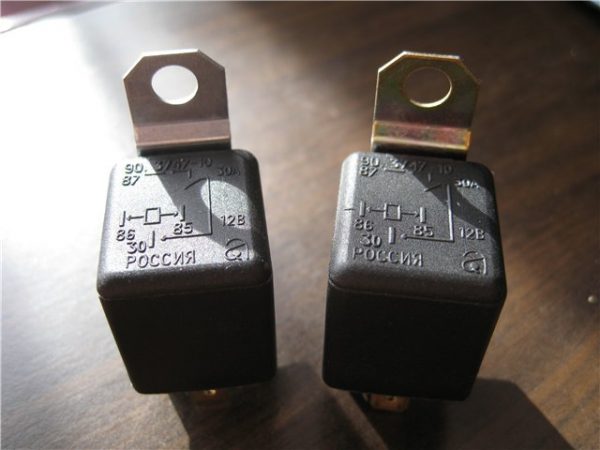
Starter relay VAZ 2107: purpose, malfunctions and repair
Not a single car can do without such a device as a starter. On the VAZ "seven" the performance of this node directly depends on the health of the relays that provide power and start the starter. If there are problems with the switching elements, the causes of the problems must be identified and eliminated in a timely manner.
Starter relay VAZ 2107
Starting the engine on the classic Zhiguli is carried out by means of a starter. The trouble-free operation of this node is ensured by two relays - control and retractor. If there is a problem with these elements, the engine will not be able to start. Therefore, it is worth dwelling on relay testing, troubleshooting, repair and replacement in more detail.
Starter relay
On all classic Zhiguli models, except for the "seven", the starter is powered directly from the ignition switch (ZZH). This design has a significant drawback - the contacts oxidize and burn, which leads to premature failure of the contact group. This is due to the fact that a current exceeding 15 A flows through the ZZH. On the VAZ 2107, to reduce the load on the lock contacts, they began to install an additional starter relay, rated for a current of 30 A. This switching element consumes a small current, which in no way reduces the reliability of the contact group.

The owners of the earlier "classic" due to the fairly frequent replacement of contacts ZZh independently mount an additional relay.
Where is
Structurally, the starter relay is located in the engine compartment on the right side. Its attachment is made to the mudguard (part of the body) with a stud and nut. It is not difficult to find the relay, for which it is enough to trace where the wires from the starter solenoid relay are laid.
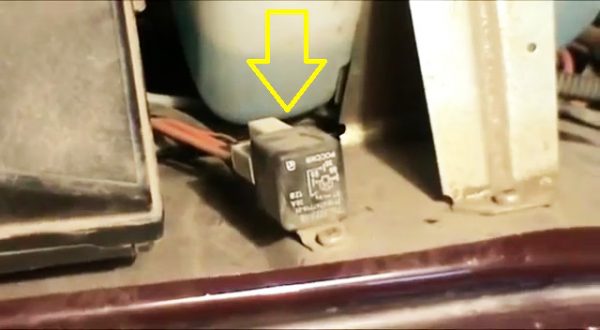
More about the starter device: https://bumper.guru/klassicheskie-modeli-vaz/elektrooborudovanie/starter-vaz-2107.html
inspection
If you have difficulty starting the engine on the VAZ 2107, you first need to check the operation of the switching relay. If the part turns out to be serviceable, you can continue to search for problems. To diagnose the switching element, you will need a multimeter or a “control” (a regular 12 V car light bulb and wires for connecting it). Relay performance is determined as follows:
- We remove the connector from the relay and check the state of the contacts in the block and on the relay itself. If necessary, we clean them with sandpaper.
- We check the presence of mass on contact 86 of the block. To do this, we check the resistance relative to the body with a multimeter, it should be zero.
- We measure the voltage at pin 85 while trying to start the engine. The parameter must be equal to 12 V. When the ignition is switched on, terminal 30 must also be powered. If it is present on the contacts, the problem lies in the relay.
- We remove the additional relay by unscrewing the nut with a wrench.
 To remove the additional relay, just unscrew the nut from the stud
To remove the additional relay, just unscrew the nut from the stud - We apply voltage from the battery to contacts 85 and 86 of the relay and make sure with a multimeter, setting the dialing mode, that conclusions 30 and 87 are closed to each other. If this does not happen, then the relay must be replaced.
Video: checking the power supply of the starter relay on the VAZ 2107
Solenoid relay
The starter, by its design, is a small electric motor, a special clutch (bendix) of which engages with the flywheel of the power unit for several seconds, causing the crankshaft to rotate. Despite the small size of the starter, when starting the engine, currents reaching hundreds of amperes pass through it. If power is supplied to this device directly through the ZZh, then no contacts will withstand such loads and will burn out. Therefore, to connect the starter to the power source, a special solenoid relay is used, in which contacts designed for high currents are structurally provided. This mechanism is structurally located on the starter housing.


The switching device under consideration has a number of functions:
- connecting the starter to the power source;
- engagement and retention of the bendix with the engine flywheel;
- turning off the power to the starter after the engine starts to run.
Operating principle
The retractor functions in the following order:
- When the key is turned to ZZh, an additional relay is activated.
- Power from the battery is supplied to the traction relay coil.
- Under the influence of a magnetic field, the armature goes inside the winding.
- The starter fork is set in motion and pushes the bendix.
- The starter sprocket engages with the flywheel of the power unit.
- A plate attached to the end of the retractor rod connects the contacts.
Find out about possible battery problems: https://bumper.guru/klassicheskie-modeli-vaz/generator/ne-daet-zaryadku-generator-vaz-2107.html
With the described actions, the motor starts within a few seconds. After the starter is activated, the retracting winding stops its work, and the current passes through the holding coil, due to which the armature remains in the extreme position. The presence of two windings reduces battery power consumption during engine start.
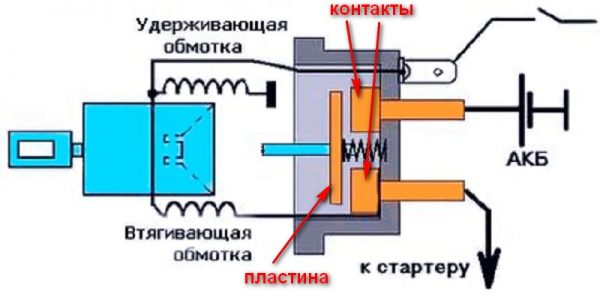

After the motor starts to work, the electric circuit of the starter opens, the current through the holding coil stops flowing, and the armature, due to the spring, takes its original position. At the same time, the clutch and nickel are removed from the relay contacts, the bendix moves away from the flywheel and the starter is disconnected from the battery.
Malfunctions
Since the retractor works every time the power unit is started and is subjected to high loads, it gradually wears out and fails. Relay malfunctions can be judged by characteristic signs:
- when the engine starts, the starter continues to work, making a buzzing sound;
- at the moment the engine starts, the relay makes a click, but the starter does not function;
- When the key is turned, the starter turns but does not engage the flywheel.
More about the VAZ 2107 engine: https://bumper.guru/klassicheskie-modeli-vaz/dvigatel/remont-dvigatelya-vaz-2107.html
Problems can occur for several reasons:
- violation of the integrity of the relay housing;
- problems with the retractor or holding coil;
- burning of contacts;
- loosening of the spring.
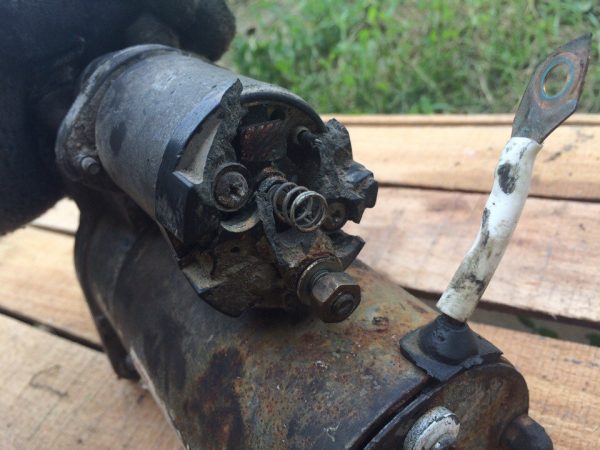

All of these problems are manifested as a result of natural wear, burnout of the windings, or destruction of parts of the assembly.
inspection
There are two ways to check the relay - without dismantling the starter and on the removed device. Let's consider both options.
By car
We carry out diagnostics with a multimeter or "controller":
- Visually assess the integrity of the relay wiring.
- We check the operation of the relay, for which we turn the key in the ignition and listen to the starter: if the click is inaudible, the relay is considered faulty.
- If there is a characteristic sound, but the starter does not turn, the contact nickels in the relay itself may be burnt. To check, we remove the chip that comes from the ZZh and close two threaded contacts between each other. With this connection, the starter will be powered bypassing the relay. Rotation of the starter will indicate a problem with the switching element.
- We connect the multimeter to the "+" relay, i.e., to the contact where power comes from the battery, and connect the minus to ground. We turn on the ignition and, if the voltage is below 12 V, then most likely the battery charge is not enough to start the engine, but enough to trigger the relay.
Video: starter diagnostics without removal from the car
On the removed starter
Before dismantling the starter, it is necessary to perform several steps that will allow you to determine the malfunction:
- we check the condition of the battery and starter terminals, the battery charge and, if necessary, clean the contacts with sandpaper;
- determine the performance of the starter relay.
If the listed actions did not give results and the starter still does not work properly, we will dismantle it from the car. We clean the assembly from contamination, clean the contacts, after which we check:
- We install the starter near the battery.
- We connect the battery and the starter using thick wires with "crocodiles", for example, a kit for "lighting up". We connect the minus of the battery to the case, plus we apply it to the contact of the traction relay. If there is a distinct click of the relay and the removal of the bendix, then this indicates the working condition of the relay. If the retractor does not work, then it needs to be replaced or repaired.

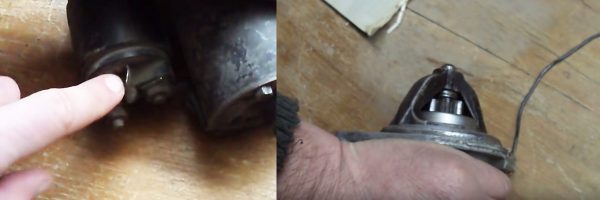 To check the traction relay, we supply power to its output from the battery plus
To check the traction relay, we supply power to its output from the battery plus - At the same time, we check the performance of the starter, for which we apply “+” to the threaded contact of the relay and close it with the output of the solenoid relay. The removal of the clutch and the rotation of the starter will indicate the operating condition of the assembly as a whole.

 To check the full performance of the starter, we connect the battery plus to the threaded contact of the relay, as well as to the enable output of the relay itself
To check the full performance of the starter, we connect the battery plus to the threaded contact of the relay, as well as to the enable output of the relay itself - If the relay turns on, but a bounce is emitted, then this indicates a malfunction of the coils. To diagnose the retractor, remove it from the starter, remove the core along with the spring. We turn on the multimeter to the limit of measuring resistance and connect the device in turn to the mass and windings. The resistance should be within 1-3 ohms. If you insert a core, it should increase to 3-5 ohms. At lower readings, there is a possibility of a short circuit in the coils, which requires the replacement of the relay.
Video: checking the starter traction relay


Watch this video on YouTube
Which relay to choose
Retractor relays are collapsible and non-collapsible. The first design is older, but such products are interchangeable with the second option. For the VAZ 2107 and other "classics", the device in question is produced by several manufacturers:
- KATEK and KZATE (Samara);
- BATE (Belarus);
- "Kedr" (Chelyabinsk);
- Dynamo AD (Bulgaria);
- Iskra (Belarus).
From the above list, the products of KATEK and KZATE are of the highest quality. The cost of retractor relays from these manufacturers is about 700–800 rubles.


Repair of the traction relay
The dismantling of the solenoid relay is necessary in two cases - to repair or replace the mechanism. Removing it is not difficult, but first you need to dismantle the starter itself from the car.
Removing the starter and relay
From the tools for work you will need the following list:
- flat screwdriver;
- key for 8, 10 and 13.
The procedure is as follows:
- We remove the terminal from the negative battery.
- We unscrew the starter mount to the clutch housing.

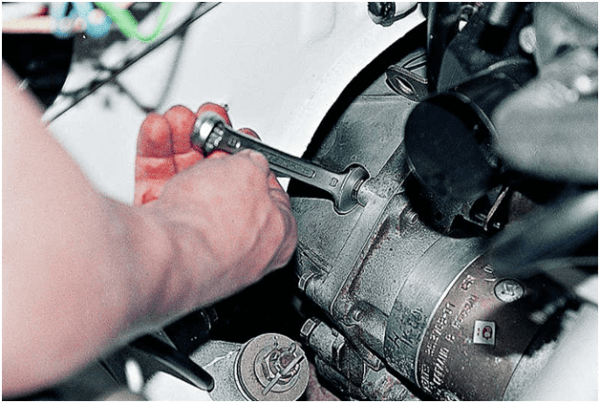 The starter is attached with three bolts to the clutch housing, unscrew the top two
The starter is attached with three bolts to the clutch housing, unscrew the top two - Use the head to unscrew the starter fasteners from below.

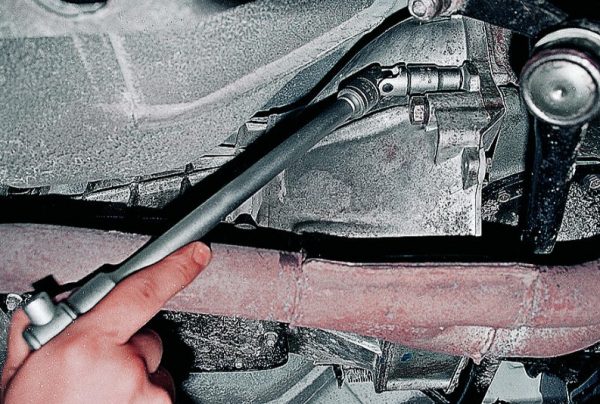 Unscrew the lower bolt with the head and extension
Unscrew the lower bolt with the head and extension - Disconnect the connector from the output of the traction relay.

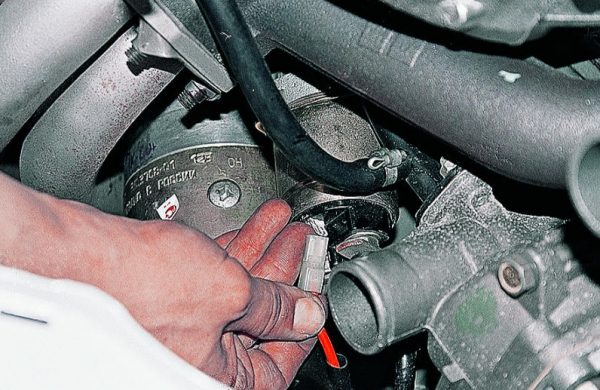 From the traction relay, remove the connector for turning on the relay itself
From the traction relay, remove the connector for turning on the relay itself - We unscrew the wire fastening nut, which connects the contact of the retractor relay to the battery plus.

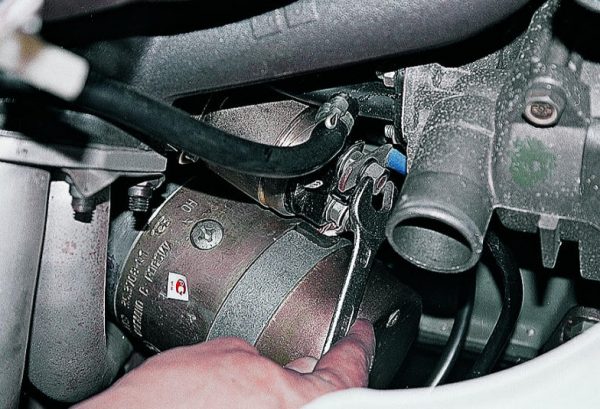 We unscrew the power terminal with the relay with a key of 13
We unscrew the power terminal with the relay with a key of 13 - We take out the starter assembly.

 Putting the starter to the side, pull it up
Putting the starter to the side, pull it up - We unscrew the fasteners of the terminal and bend it so that there is no interference with further dismantling.

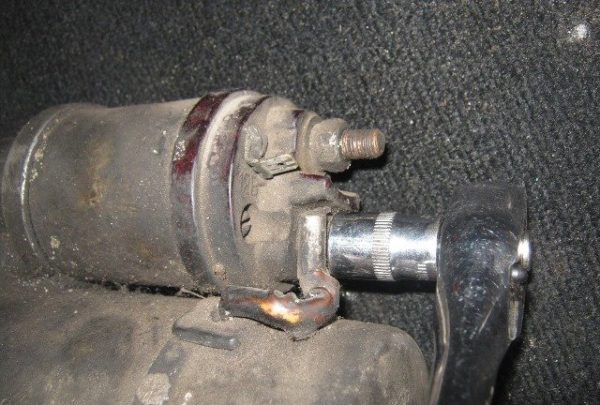 We also unscrew the power terminal of the starter winding with a key or head
We also unscrew the power terminal of the starter winding with a key or head - We unscrew the bolts securing the relay to the starter.

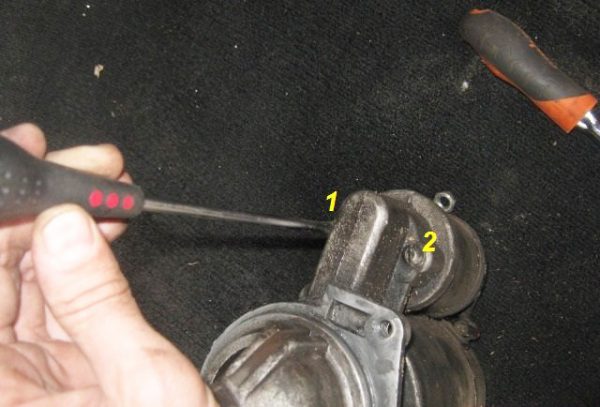 The relay is attached to the starter with two screws, unscrew them with a screwdriver
The relay is attached to the starter with two screws, unscrew them with a screwdriver - We remove the switching device.

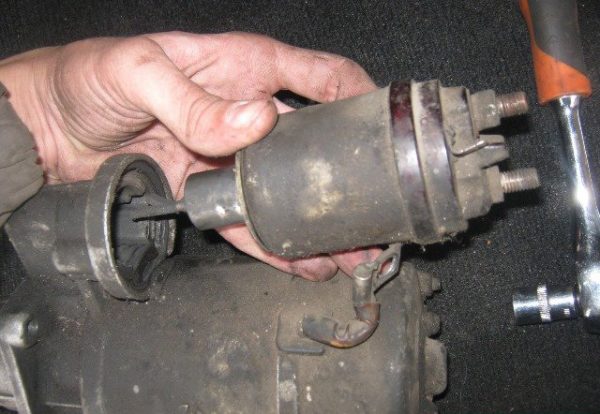 Having unscrewed the fasteners, we take out the traction relay from the starter housing
Having unscrewed the fasteners, we take out the traction relay from the starter housing
Disassembly
The solenoid relay is disassembled in order to replace or clean the contacts (pyatakov):
- With a key or head for 8, we unscrew the fastening of the relay cover to the housing.

 We unscrew the fastening of the relay cover to the housing
We unscrew the fastening of the relay cover to the housing - We press on the bolts and take them out from the back.

 Having unscrewed the nuts, we press on the bolts and remove them from the housing
Having unscrewed the nuts, we press on the bolts and remove them from the housing - We dismantle two contacts, for which we unscrew the nuts on the cover.

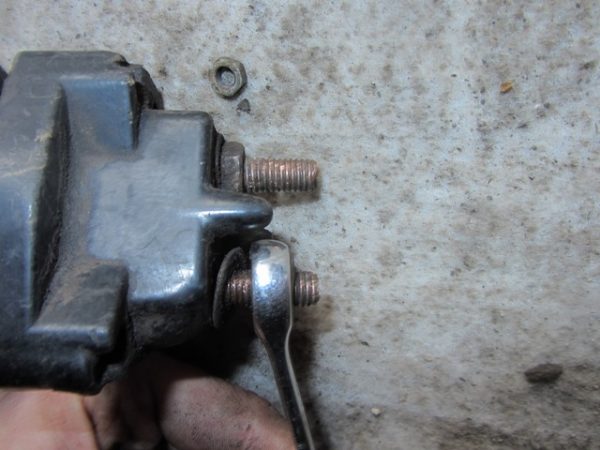 The power contacts of the relay are fastened with nuts, unscrew them
The power contacts of the relay are fastened with nuts, unscrew them - Gently push the relay cover aside, as the wire will prevent complete removal.
- We take out the pennies from the lid.

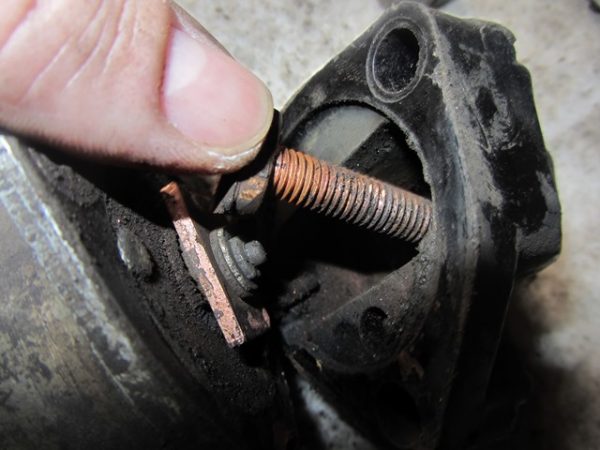 We take out the contact pads from the cover
We take out the contact pads from the cover - Using fine sandpaper, we clean the contacts and the central plate from soot. If the pennies are badly damaged, replace them with new ones.

 We clean the contacts with fine sandpaper to remove burnt areas.
We clean the contacts with fine sandpaper to remove burnt areas. - We assemble the relay and install the starter in the reverse order.
Video: starter traction relay repair


Watch this video on YouTube
Malfunctions of the auxiliary and solenoid relays lead to difficulties or inability to start the starter. You can identify the cause of the problem by characteristic signs, and repairs can be carried out by each motorist according to step-by-step instructions.



